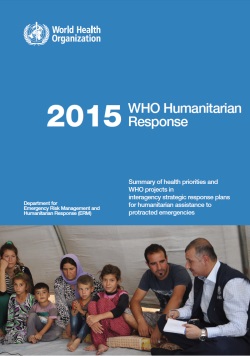2015 WHO Humanitarian Response: Summary of health priorities and WHO projects in interagency strategic response plans for humanitarian assistance to protracted emergencies
 In 2014, WHO and humanitarian health partners responded to an unprecedented number of concurrent major humanitarian crises. Fuelled by conflict, the crises in the Central African Republic, Iraq, South Sudan and Syrian Arab Republic have threatened the health of tens of millions of people and pushed health services to the limit, in some cases to the point of collapse. Typhoon Haiyan in the Philippines left millions of people without access to basic services and health care in just a few hours. WHO, using the grading system adopted in 2013, declared these emergencies Grade 3, requiring a global response by the Organization.
In 2014, WHO and humanitarian health partners responded to an unprecedented number of concurrent major humanitarian crises. Fuelled by conflict, the crises in the Central African Republic, Iraq, South Sudan and Syrian Arab Republic have threatened the health of tens of millions of people and pushed health services to the limit, in some cases to the point of collapse. Typhoon Haiyan in the Philippines left millions of people without access to basic services and health care in just a few hours. WHO, using the grading system adopted in 2013, declared these emergencies Grade 3, requiring a global response by the Organization.
In responding to five Grade 3 crises, including the Ebola crisis, as well as delivering humanitarian health operations in 26 other countries, WHO has demonstrated the Organization’s ability to respond to major health emergencies. But the huge stresses posed by these simultaneous and protracted crises have demonstrated the extent to which the capacity of the humanitarian system is stretched.
WHO continues to find ways to become more effective and efficient. Experience from the response to the Typhoon Haiyan in the Philippines, for example, has led to better coordination of the foreign medical teams that arrive in the aftermath of a sudden-onset disaster. WHO has strengthened its collaboration with members of the Health Cluster and has also engaged a number of stand by partners (CANADEM, iMMAP, Norwegian Refugee Council and RedR Australia) to increase the global surge capacity.
The pressure of delivering in multiple emergency situations has also led to the use of new implementation modalities. In the Central African Republic, WHO facilitated the payment of the salaries of healthcare workers so that they could return to work, and in the Syrian Arab Republic and Iraq, WHO has found ways to deliver medicines and health services in the middle of intense conflict through local NGOs.
In 2015 WHO and health partners are responding to protracted emergencies in 32 countries. The total number of people targeted for health assistance as of March 2015 is 74.9 million. Funding requirements for health partners appealing through the strategic response plans coordinated by OCHA stand at US$ 18 billion, out of which WHO requires US$ 499 million. These funding requirements will increase over the year as additional strategic response plans are published.
 This document provides an overview of health priorities and WHO projects in the strategic response plans that have been developed to meet humanitarian needs in protracted emergencies in Afghanistan, the Central African Republic, the Democratic Republic of the Congo, Iraq, Myanmar, occupied Palestinian territory, the Sahel region (Burkina Faso, Cameroon, Chad, Mali, Mauritania, Niger, Nigeria, Senegal and The Gambia) Somalia, South Sudan, Sudan, the Syrian Arab Republic, Ukraine and Yemen in 2015. It also includes support to refugees from the Central African Republic, South Sudan and the Syrian Arab Republic who have fled to neighbouring countries.
This document provides an overview of health priorities and WHO projects in the strategic response plans that have been developed to meet humanitarian needs in protracted emergencies in Afghanistan, the Central African Republic, the Democratic Republic of the Congo, Iraq, Myanmar, occupied Palestinian territory, the Sahel region (Burkina Faso, Cameroon, Chad, Mali, Mauritania, Niger, Nigeria, Senegal and The Gambia) Somalia, South Sudan, Sudan, the Syrian Arab Republic, Ukraine and Yemen in 2015. It also includes support to refugees from the Central African Republic, South Sudan and the Syrian Arab Republic who have fled to neighbouring countries.
Download the 2015 WHO Humanitarian Response Report here.
Tip: More up to date educational events dealing with humanitarian assistance can be found online on the Education Database »medicine & health«.
